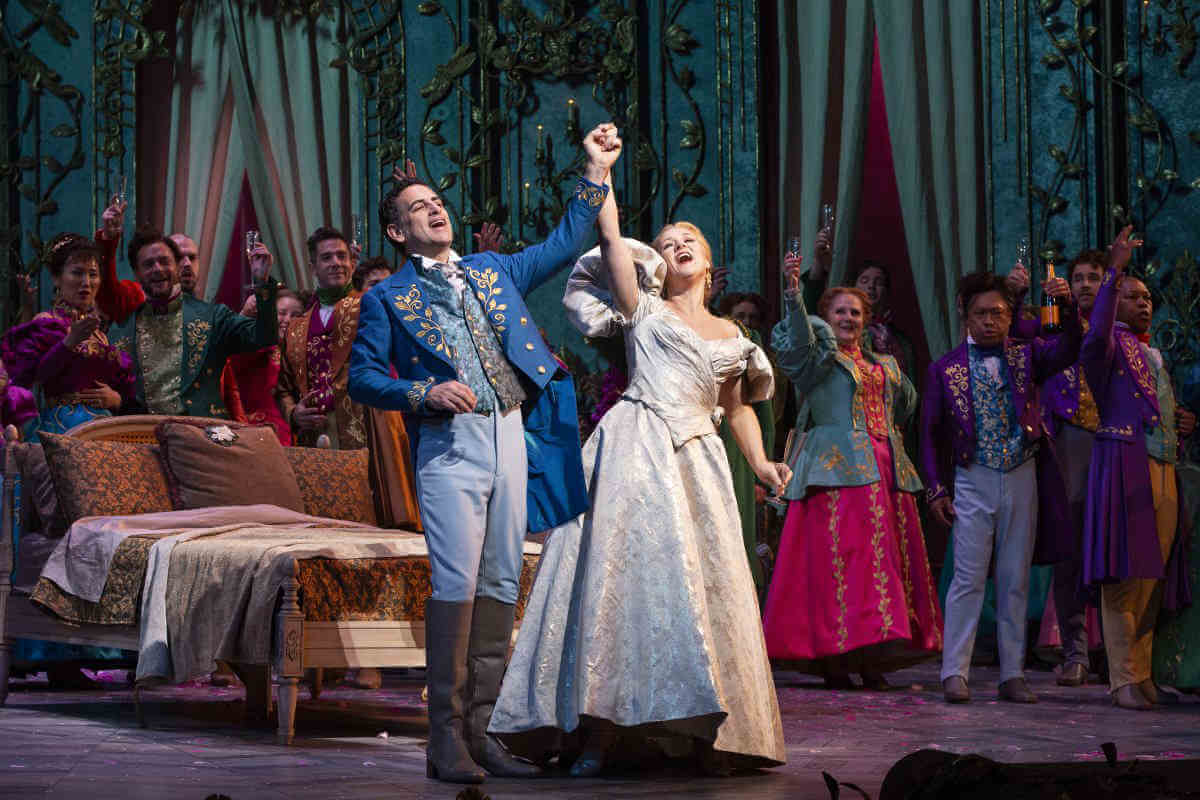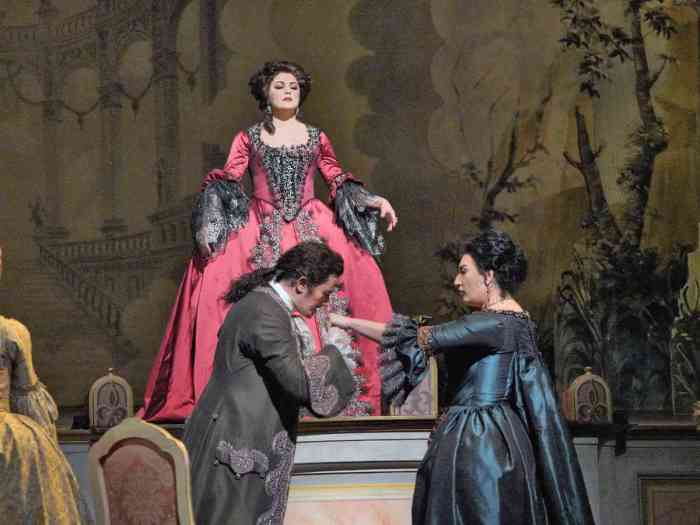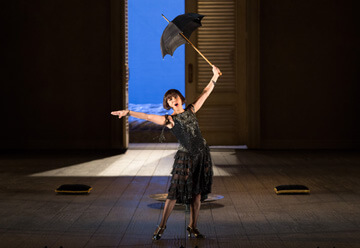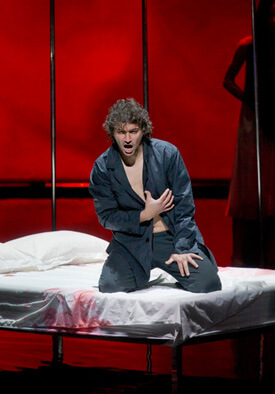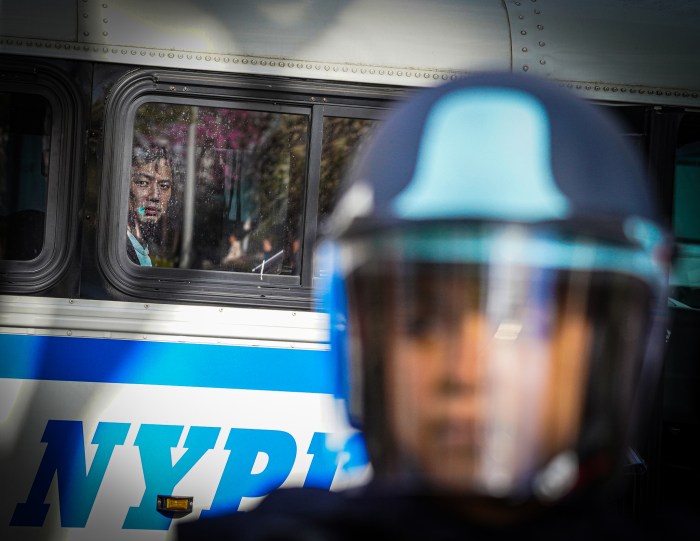Yannick Nézet-Seguin officially took his place as the Metropolitan Opera’s new music director with a splashy, starry new production of Verdi’s evergreen romantic drama “La Traviata.” The director chosen for this important commission was Michael Mayer, who debuted at the Met in 2013 with a flashy neon-lit new production of “Rigoletto” set in 1960s Las Vegas.
Mayer’s “Traviata” production, like Sir David McVicar’s new “Tosca” production last season, replaces a stark modernist production with a return to the romantic and representational, sprinkled with a few updated touches to add a little dramatic fiber to the pretty eye candy. Willy Decker’s 2010 production (which premiered at Salzburg in 2005) was an expressionist study in black and white with minimalistic sets and maximalist stage direction. Every stylized gesture for the cast was precisely choreographed. It was a cool, even clinical take that emphasized Violetta’s isolation and suffering at the expense of the other characters. In contrast, Mayer has borrowed concepts from “Traviata” productions past and present filling the stage with acid colors, decorative furniture, gilded pianos, ormolu screens, and candelabras. Liberace would feel right at home in Violetta’s parlor.
Following Franco Zeffirelli’s 1958 Dallas production for Callas, Mayer stages the prelude with Violetta on her sickbed remembering her past which then plays out onstage as a flashback. (Of course, one problem with this concept is that Violetta is flashing back to events she did not witness like Germont and Alfredo’s meeting in Act II or the events at Flora’s party before Violetta arrives.) Each act is played as a different season of the year — Violetta and Alfredo fall in love at her party in the Spring, escape to the country for the Summer, split up in the Fall, and Violetta dies in Winter. Violetta’s bed remains center stage throughout, symbolizing both the deathbed framing device and the courtesan’s erotic workplace.
Some of Mayer’s updated touches are reasonable. Others, like making Alfredo’s virginal sister a silent onstage character witnessing the action, are foolish. Germont would never allow a sheltered young girl into the home of a prostitute or the sick room of a consumptive since the poor girl could be contaminated with either Violetta’s wicked ways or her illness. The only trope that was missing was a large clock ticking the hours of Violetta’s life away — Decker had already taken that idea to its limit.
Christine Jones’ unit set is a curved rotunda wall with arched openings and a ceiling oculus from which flowers, chandeliers, or snow descend to denote the change of seasons and locale. The unit set looks rather oversized for the country villa but instantly transforms for Flora’s salon without a pause. Susan Hilferty’s costumes are a riot of bright colorful fabrics accented with gold embroidery. The Act I male partygoers wear burgundy, teal, and purple cutaway jackets with knee boots like refugees from the Stahlbaum’s “Nutcracker” Christmas party. Flora’s Act II party resembles Orlofsky’s ball from “Die Fledermaus” with everyone in brocaded fancy dress. Lorin Lotarro’s Act II toreador ballet has the dancers done up as zombie extras from Michael Jackson’s “Thriller” music video vogue-ing to Verdi. (Zeffirelli dancing cows come back, all is forgiven…) The smock apron Annina wears in Act III is of shiny blue silk. This isn’t 19th century Paris as historical recreation but as a theme park fantasy world filtered through Hollywood musicals and Disney cartoons. It looks pretty and bright shiny new. You can see where the money was spent, so the Met audience seemed to enjoy it.
The main advantage of replacing the Willy Decker production is that this one can play more easily in repertory rotation and with varied casting. Conceived as a festival presentation, Decker’s meticulously detailed production required hours of rehearsal even in revival (often with Decker restaging). The acting, costuming, and physical demands required of Violetta and Alfredo limited who could be cast in Decker’s production. Mayer’s production can be thrown onstage with a few days of rehearsal featuring sopranos and tenors of any type, age, or size.
There is a smart and very musical trio of singers in the center of this floor show who work hard to upstage the scenery. Diana Damrau, an impressive Violetta in the Decker production in 2013, is not quite the strong coloratura technician she once was. Her soprano in its current estate clearly can’t take pressure at any extremes of volume or range without losing control. The repeated staccati and scales in Act I’s “Sempre Libera” started to unravel, turning shrill and forced. Damrau sagely took the low option at the climax, eschewing either the high C or E-flat. In the more lyrical Acts II and III, Damrau found herself on increasingly firm ground, gaining in musical and dramatic strength. With Maestro Nézet-Séguin’s help, Damrau turned her disadvantages into assets by working from a baseline of delicate soft singing, only rarely vocalizing full out. A naturally positive, hearty and energetic performer, Damrau brought a soft-grained approach subtly highlighting Violetta’s feminine vulnerability and frailty. Initially rather frenetic, Damrau’s acting gains in quiet focus and eloquence, overcoming Mayer’s often trite stage direction. She is a probing musician and committed high energy performer.
Returning to the Met after an absence of five seasons, Juan Diego Flórez made his role debut as Alfredo in this production. Again Flórez’s voice seemed slight for the role. Again Nézet-Séguin catered to his weaknesses, keeping the orchestral volume level down in his solo moments. Flórez’s bel canto facility ensured that the turns and grace notes in the “Brindisi” and “Parigi o Cara” have never sounded better. He phrases with charm and elegance. When Verdi calls for power, Flórez’s tone can turn nasal and blatant. As an actor, I don’t see much difference between Flórez’s Alfredo and his Ernesto or Tonio or Elvino. But you do see why Violetta falls in love with him.
The only major Verdian voice on the stage was that of Hawaiian baritone Quinn Kelsey as Papa Germont. Kelsey’s voice is big, broad, and imposing, with enveloping legato phrasing that evokes paternal concern and tenderness. His rich sound can turn blunt in high or fast moments but he has power and authority in spades.
Nézet-Séguin’s conducting was alert to details, attentive to the singers and generally rather moderate in tempo. His reading could be over-controlled but the Metropolitan Opera Orchestra sounds as good as it ever has — clearly the players love him and so does the Met audience. The musical edition is fuller than the usual but some traditional cuts are opened while others are preserved; sometimes we get one verse only and sometimes both verses.
If the design concept of the Mayer production were less garish, the memory play concept would seem less artificial. Something poetic like the black and white French romantic fantasy films of the 1940s of Marcel Carné or Jean Cocteau would evoke the right atmosphere. Dreamlike visuals with soft-focus misty backgrounds, delicate pastel shades, and chiaroscuro lighting — more like Cocteau’s “Beauty and the Beast” and less Disney’s “Beauty and the Beast” with better songs.

